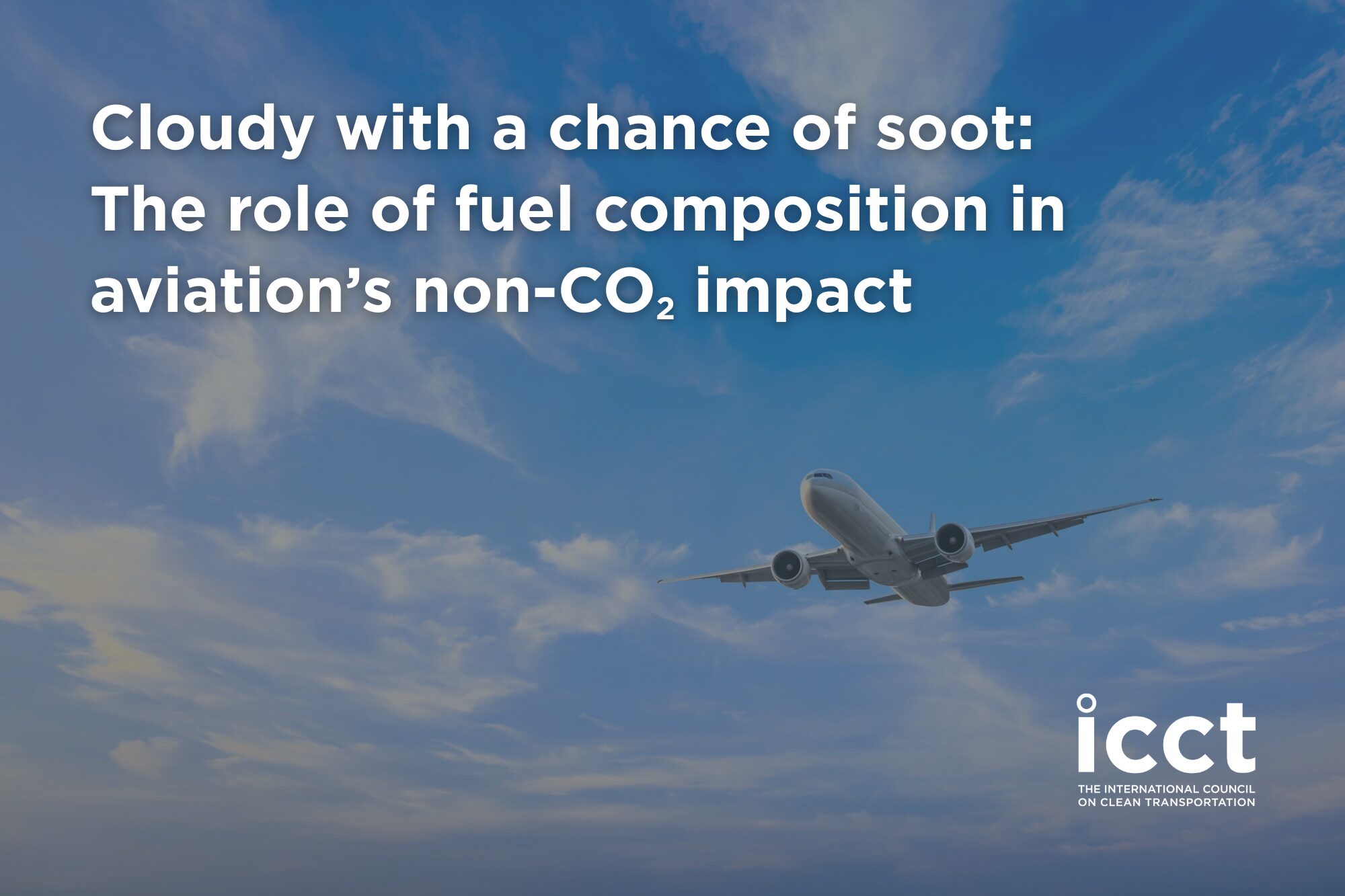Jet fuel can be produced from several different sources, including fossil fuels, feedstocks of biological origin, and captured carbon. Depending on the feedstock used, the lifecycle carbon dioxide (CO2) emissions of the fuel can vary widely. Robust sustainability criteria prioritizing minimal life-cycle carbon intensity can help to ensure that sustainable aviation fuels (SAFs) are truly low carbon, which is crucial to achieving aviation’s 2050 net-zero target.
Unlike CO2 emissions, the non-CO2 emissions associated with combusting aviation fuels are not dependent on the feedstock of the fuel, but rather its composition. Specifically, fuel composition plays a key role in determining the particulate matter (PM) emissions and contrail impact of combustion within a given aircraft engine. We’ll start by understanding how these are related.
Regardless of the feedstock used to produce it, jet fuel can be engineered with varying levels of specific types of hydrocarbons (such as aromatics and naphthalenes), as long as the resulting fuel meets relevant standards set by ASTM International—an organization that sets technical standards for a range of industries. ASTM has separate standards for conventional fossil jet fuel and SAF.
Conventional fossil jet fuel, which makes up nearly all aviation fuel used today, typically has a fuel hydrogen content of about 13.8%. Fuel hydrogen content has been found to be the best correlating parameter when assessing the relationship between fuel composition and non-volatile particulate matter (nvPM) emissions, or soot. These ultrafine particulates can be measured at the aircraft engine exit in the solid phase, typically under 100 nm in diameter. On the other hand, volatile particulate matter (vPM) does not exist at the engine exit and forms in the exhaust plume, where it later condenses into particles. vPM formation in aircraft has been tied to compounds such as sulphates in fuels and vented engine lubrication oil.
SAF tends to have a higher hydrogen content than typical fossil jet fuel and little to no aromatics and sulfur, which translates into fewer PM emissions. Modeling results from a 2022 study by Teoh et al. estimated that fleetwide adoption of 100% SAF in the North Atlantic would result in 52% lower nvPM emissions. Likewise, experimental results from the 2024 ECLIF3 project, the first in-flight test campaign running on 100% SAF, measured a 35% reduction in nvPM particles.
Now for how this relates to contrails. This is a bit more complicated, because contrail formation is dependent on both engine emissions and meteorological conditions. While there is uncertainty about the climate impact of individual contrails, there is agreement that collectively, they have a net warming impact. The ideal meteorological conditions for persistent contrail formation include hot engine exhaust, cold temperatures, and high humidity. Areas where the meteorological conditions are conducive to contrails are called ice supersaturated regions, or ISSRs. When an aircraft is flying through an ISSR, ice crystals can nucleate around particulate matter at the engine exit and emissions plume, spreading to form contrails.
Recent modeling and flight tests indicate that nvPM reductions from SAF use can enable reductions in persistent contrail formation in rich-burn engines, which make up most of the existing fleet. The modeling results from Teoh et al. noted above estimated a 44% reduction in contrail radiative forcing resulting from the modeled decrease in nvPM emissions; climate modeling using the ECLIF3 experimental results showed a 26% reduction.
Although further flight testing is needed to rigorously quantify this relationship for different engines, there is a clear, observed trend of reduced contrail radiative forcing in rich-burn engines resulting from SAF use. When weighing the benefits of SAF relative to conventional fossil jet fuel, the impact of SAF thus widens considerably if you include the additional air quality and climate benefits coming from reduced PM emissions and contrail formation.
Importantly, the ability of SAF to contribute to non-CO2 emissions reductions will be limited by its penetration into the aviation fuel supply. In 2024, SAF made up only about 0.3% of global jet fuel use; even in the most ambitious existing SAF mandate, which took effect in the United Kingdom this year, SAF blends reach 10% in 2030. Uniform blending of SAF at low percentages greatly dilutes any non-CO2 emissions benefits. In this context, avoidance may be a more cost-effective and accessible solution to address contrails in the near term.
Meanwhile, to maximize the potential non-CO2 emissions reductions from fuel composition, airlines could explore the feasibility of hydroprocessing fossil jet fuel until SAF is widely available. Hydroprocessing includes refinery processes, such as hydrotreatment and hydrocracking, that add hydrogen to a fuel at high temperatures and pressures, greatly reducing aromatic and sulfur content and, consequently, PM emissions. When considering this option, non-CO2 climate and air quality benefits should be weighed against potential tradeoffs at refineries coming from the required energy input for these processes. However, initial studies indicate that the overall climate benefit of using hydroprocessed jet fuel could outweigh penalties from additional refinery emissions and serve as a promising near-term mitigation strategy as SAF production grows in parallel.
It is clear that the chemical properties of jet fuel play a key role in aviation’s non-CO2 impact. As the aviation sector works to mitigate its climate impact, policymakers could consider targeted use of low-carbon SAF on contrail-prone routes and using hydroprocessed fossil jet fuel to unlock near-term climate benefits and improved local air quality.
